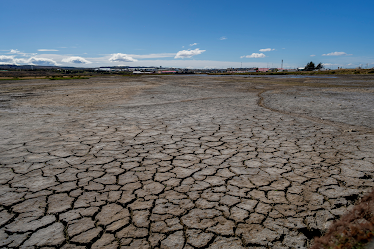Final Hazards Report
Chile is a beautiful nation - home to 19.6 million, full of life, mountains, bodies of water and much much more. Unfortunately, Chile has been struck by harsh natural hazards due to its location and surroundings. Two natural hazards that cause major issues to the nation of Chile and its people are earthquakes and extreme weather conditions - drought in this case. Chile is frequently affected by seismic activity because it lies right on top of the South American plate - to the west, it is neighboring with the Nazca plate. It is important to note Chile’s proximity to the Nazca plate, because it also connects it to the Pacific plate underwater. The high levels of seismic activity present in the nation + the multiple plates raise the possibilities for following natural hazards. It is important to mention that the south American plate is a convergent plate - this means that it places Chile in a position to deal with explosive volcanoes, earthquakes, flooding and landslides.
I chose to focus my attention on Chile's seismic activity because of its frequency and the mass amount of damage that tends to follow after major activity. Chile has dealt with the same extreme weather conditions for the past 15 years- droughts. This has occurred due to the long dry periods. It is important to address the droughts in Chile because they have severely impacted the environment and the people of Chile and fueled the deadly wildfires that have struck Chile in the frequent years.
The nation of Chile has done a great job in reducing the risk of the seismic activity and combating the ongoing drought it has been struck with when comparing it to the strategies of other countries. Chile has a high risk of seismic activity, therefore they have focused lots of attention on the issue and have even designated funds to support research and reduce the dangers that are caused by the issue. An example of this would be the IPRED, also known as the International Platform for Reducing Earthquake Disasters. What the IPRED does is that it conducts research to better understand within the field of seismology. They gather their research and from there develop earthquake engineering, this is to minimize the damage caused by earthquakes on the houses and buildings in Chile to reduce the amount of damage on the population of Chile. That is just one of the many organizations that Chile has.
Chile has been affected by a drought for the past 15 years. The nation has developed several strategies throughout the years to minimize the damage. An example of the work that the nation has done has been - taking a natural approach or natural solutions. This means, reforestation, forest protection, and wetland reforestation. This has been done in attempts to raise the perception in central chile - where most of the population is present and where most of the damage has been done due to the drought.
Central Chile is the area that seems to be most affected by most natural hazards. Upon further investigation, the source ThinkHazard reports that the areas with highest risk of seismic activity are those that follow - Bio Bio, Maule,ValParaiso, Coquimbo, Atacama, and Tara paca. These areas are all at risk of being struck by seismic activity and the natural hazards that follow such as, fires, landslides, liquefaction, and even tsunamis.
There is no Low zone in Chile to avoid seismic activity, most areas are highly prone to seismic activity and the rest are at a medium risk. If I had to select an ideal area to reside in to avoid natural hazards I would select to reside in the Magallanes region. This is due to the lower risk of being severly affected in case of seismic activity when comparing it to others regions in Chile. By residing in the Magallanes I would increase my chances of survival and reduce muy chances of having to deal with other natural hazards such as tsunamis, wild fires, land slides, and volcanic activity.
I have used several sources throughout my investigation, they are as follow -
“Atmospheric Rivers Swamp Central Chile.” NASA, NASA, earthobservatory.nasa.gov/images/151783/atmospheric-rivers-swamp-central-chile#:~:text=For%20more%20than%20a%20decade,and%20snow%20to%20the%20region. Accessed 1 Apr. 2024.
“A Strained Water System in Chile.” NASA, NASA, earthobservatory.nasa.gov/images/146577/a-strained-water-system-in-chile. Accessed 1 Apr. 2024.
“Water Conservation in Chile.” The Nature Conservancy, 1 July 2018, www.nature.org/en-us/about-us/where-we-work/latin-america/chile/stories-in-chile/our-work-in-chile-water/#:~:text=%C2%A9%20Nick%20Hall-,Protecting%20and%20restoring%20critically%20important%20habitats,overall%20water%20quality%20and%20availability.
“Earthquake and Tsunami in Chile: Massive Evacuation and Building Codes to Reduce Loss of Life.” UNESCO.Org, www.unesco.org/en/articles/earthquake-and-tsunami-chile-massive-evacuation-and-building-codes-reduce-loss-life#:~:text=Chile%20is%20actively%20involved%20in,especially%20on%20buildings%20and%20housing. Accessed 6 Feb. 2024.
“Inspire: Chile Margin 2012.” INSPIRE: Chile Margin 2012: Education: Expedition Purpose: NOAA Office of Ocean Exploration and Research, oceanexplorer.noaa.gov/explorations/12chile/background/edu/purpose.html#:~:text=Chile%2C%20and%20the%20other%20countries,called%20the%20East%20Pacific%20Rise. Accessed 6 Feb. 2024.
Lam, Wallace. “Disaster Recovery Comparison: Earthquakes in Chile & Haiti.” Vision of Humanity, 25 Sept. 2023, www.visionofhumanity.org/how-positive-peace-makes-a-difference-during-a-disaster/#:~:text=Chile%20and%20Haiti%20are%20among,and%20volcanic%20eruptions%20frequently%20occur.


Comments
Post a Comment